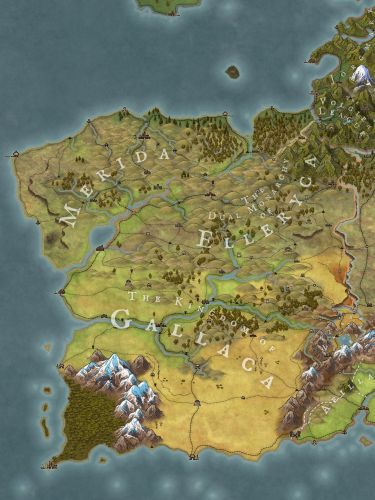Southwest Galisea
Bounded on its eastern edge by the vast mountain ranges and surrounded on three sides by great bodies of water, Southwest Galisea is a quasi-peninsula in the southern and western portions of Galisea. The region of Southwest Galisea is comparatively disconnected from the central Yulan-Tealestrian trading hubs, resulting in these lands being somewhat more disconnected from time and seemingly less advanced. The region is home to a handful of decentralized, predominantly feudal, nations though the winds of change have begun to blow, and these realms may soon be dragged kicking and screaming into the modern world.
Southwest Galisea is comparatively sparsely populated, with roughly 23,563,000 denizens residing in the whole area. Though this is a relatively large population, it is spread over a comparatively wide area as Southwest Galisea is one of the larger regions in the continent. Local economies lacking significant surpluses, a lack of strong central authorities, and, in the modern era, frequent incursions from nomadic horse raiders from Aarum have all presented significant downward pressures on the total population.
Southwest Galisean societies tend to retain highly feudalized societies with reigning sovereigns have comparatively limited powers, and foci of influence being relatively decentralized. This is especially true the further north one travels in the region, and has been a driving force in limiting rates of urbanization and the development of more advanced manufacturing capability.
Geography
Southwest Galisea is a quasi peninsula located at the westernmost edge of the larger Galisean continent. It is bounded on three of its sides by ocean. To its north lies the Sea of Erigan, its west by the Great Western Ocean, and its south by the Yulan Ocean. On the landward edge, most of the land in Southwest Galisea is bounded by mountains, with the Odric Mountains to the south and the Velyarg Mountains. There is a single relatively flat land area between the Southwest Galisea and the rest of the continent, the Nabari Plateau, which lies almost due east from the peninsular lands.
The region has a handful of distinct sub-regions that divide the area. In the southernmost land primarily consists of the Llanura a hot, relatively dry land that dominates most of the territory of the Kingdom of Gallaca. The Tierra Lanternas at the southwestern corner is one of the largest swamps in the known world. In the center of the region lies the Gallenda and Tinib watershed region which serves as a major crossroads between the three major nations in the region, as well as becoming the economic heartland of both Gallaca and Merida. Along the northern coast lies Meridie which is the heartland of Merida, a land of many small rivers and dense forests.
Southwest Galisea possesses a lot of valuable land, with most of the land being capable of supporting some amount of agriculture or another viable economic purpose. Most of the land is relatively humid, with plenty of rain, with the chief exception being the Llanura, which still receives enough seasonal precipitation to maintain a functional and relatively diverse ecosystem. Despite this, a good deal of decentralization has limited settlement of the area somewhat leaving the lands fairly empty, and allowing frontiers and wildlands to develop.
Ecosystem
Southwestern Galisean ecosystems are quite diverse with a broad range of climatic regions and highlands dividing territory and allowing for a broad range of biodiversity. This is especially true in the north which is broken up even further by many highlands, and oceanic currents creating a broader range of climate conditions. It is home to many thousands of distinctive species living throughout the area. At the apex are the Dragons which are more common in this area than most other areas of the known world, ranging down from them are a vast array of animals, down to many species of plant.
Most of the biomes of the region consist of rolling hills, with several plains that take up much of the overall landmass, and more wild forested regions that are more common in the quieter parts of Southwest Galisea. As a rule, things become wetter and colder the further north one travels, with forested regions becoming even more common as one goes north as well. The south is much more like the Aeillan climate, with grassier areas and fewer forests. All lands in Southwest Galisea are subject to seasonal cycles, with four distinct seasons being observed in the entire region.
The area is densely settled, and this has had a major impact on the overall ecosystem. Sentient settlements take up roughly forty percent of the land in Southwest Galisea, though Elleryca and Merida are less settled than Gallaca. Most of this sentient occupation has been clearcutting for agricultural purposes, though other activities such as foresting, mining, and urban settlement are also obviously present as well. Sentient occupation of the region has had an impact on the ecosystem with many resources being exploited perhaps to aggressively and byproducts of sentient settlement polluting the wild biomes.
Maps
-
Southwest Galisea
A map of the southwestern corner of the Galisean continent. Home to Gallaca, Merida, Elleryca, and Nimeara.
Type
Region
Location under
Included Organizations
Related Ethnicities



